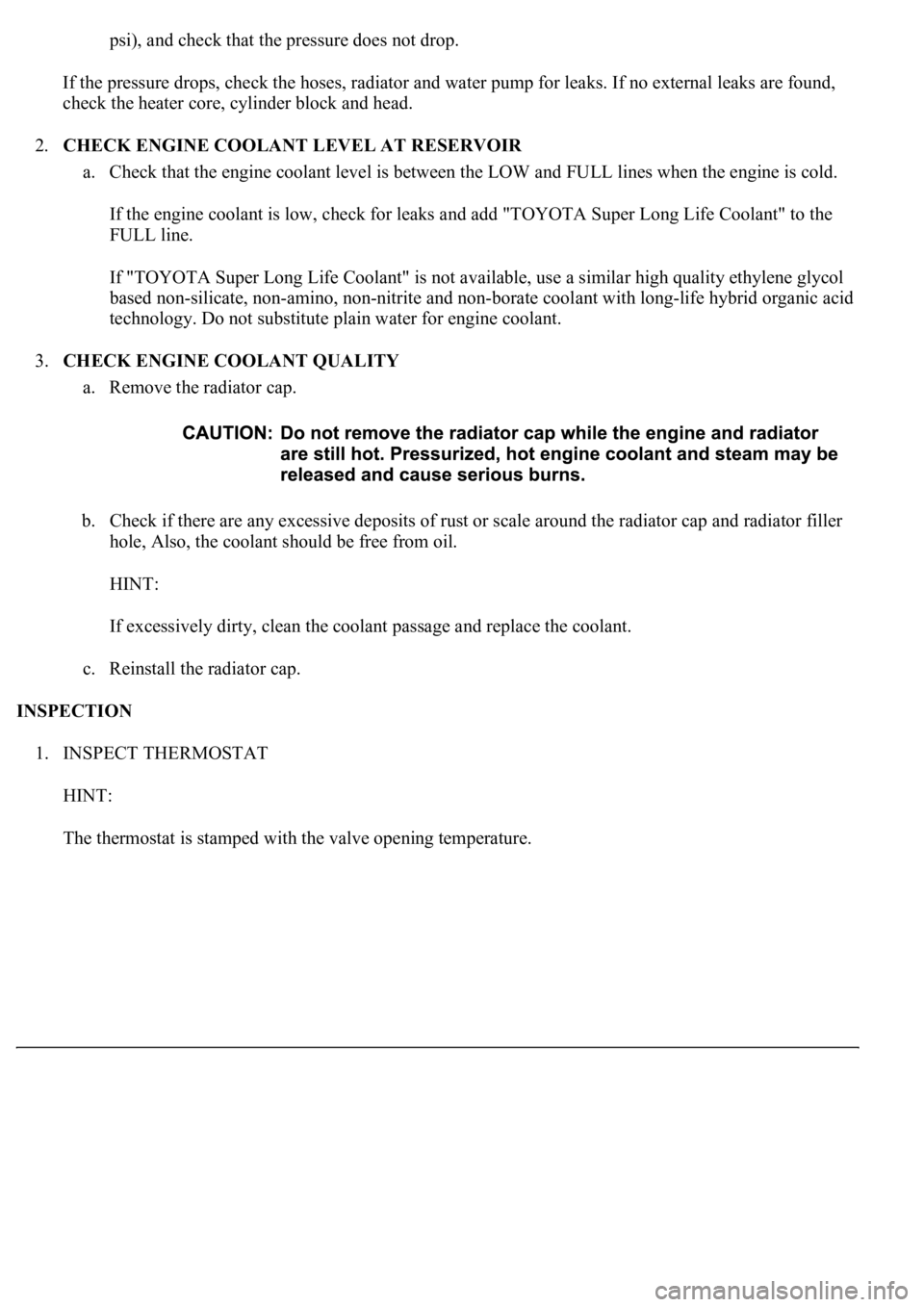Page 1811 of 4500
OK:
Needle indication is normal.
NG: REPLACE COMBINATION METER ASSY (SEE OVERHAUL
)
OK: GO TO NEXT STEP
2.READ VALUE OF HAND-HELD TESTER (ENGINE COOLANT)
a. Operate the hand-held tester according to the steps on the display and select the "DATA LIST".
ENGINE:
DATA LIST REFERENCE
OK:
Coolant temperature displayed on the tester is between 80°C (176°F) and 95°C (203°F) after
warning up.
NG: GO TO ENGINE CONTROL SYSTEM (SEE REPLACEMENT
)
OK: GO TO NEXT STEP
3.REPLACE COMBINATION METER ASSY
OK:
Normal operation
NG: GO TO ENGINE CONTROL SYSTEM (SEE REPLACEMENT
)
OK: END
WIRING DIAGRAM
ItemTest DetailsDiagnostic Note
COOLANT TEMPLOW /NORMAL /HI-
ItemMeasurement Item/ Range
(Display)Normal ConditionDiagnostic Note
COOLANT
TEMPCoolant Temperature / Min.: -
40°C (-40°F), Max.: 140°C
(284 °F)After warming up: 80
to 95°C (176 to 203°
F)If the value is "-40°C (-40°F)" or
"140°C (284°F)", sensor circuit is
open or shorted.
Page 1812 of 4500
Fig. 65: Driver'S Seat Belt Warning Lamp Wiring Diagram
Courtesy of TOYOTA MOTOR SALES, U.S.A., INC.
INSPECTION PROCEDURE
HINT:
If there is an open in the ground circuit (Airbag sensor assy center), the airbag sensor assy center outputs DTCs.
Perform troubleshooting with the "Supplemental Restraint System" 05-1026.
1.PERFORM ACTIVE TEST BY HAND-HELD TESTER
a. Operate the hand-held tester according to the steps on the display and select the "ACTIVE TEST".
METER:
ACTIVE TEST REFERENCE
OK:
Switch condition (ON/OFF) can be switched by ACTIVE TEST.
NG: REPLACE COMBINATION METER ASSY (SEE OVERHAUL
)
OK: GO TO NEXT STEP
ItemTest DetailsDiagnostic Note
D-BELT
REMINDIndicat. Lamp D-SEAT BELT
(OFF/ON)Confirm that the vehicle is stopped and engine
idling
Page 1818 of 4500

PROCEED WITH TROUBLESHOOTING) and A/C system (see HOW TO PROCEED WITH
TROUBLESHOOTING ).
1.PERFORM ACTIVE TEST BY HAND-HELD TESTER
a. Operate the hand-held tester according to the steps on the display and select the "ACTIVE TEST".
Standard
ACTIVE TEST REFERENCE
OK:
Indicator lamp (ON/OFF) can be switched by ACTIVE TEST.
NG: REPLACE COMBINATION METER ASSY (SEE OVERHAUL
)
OK: GO TO NEXT STEP
2.READ VALUE OF HAND-HELD TESTER (FRONT PASSENGER SEAT BELT)
a. Operate the hand-held tester according to the steps on the display and select the "DATA LIST".
SRS AIRBAG:
DATA LIST ITEM REFERENCE
OK:
Switch condition (ON/OFF) can be switched by actual operation.
RESULT:
RESULT REFERENCE
B: Go to step 6
ItemTest DetailsDiagnostic Note
P-BELT
REMINDIndicat. Lamp P-SEAT BELT
(OFF/ON)Confirm that the vehicle is stopped and engine
idling
ItemMeasurement Item/ Range
(Display)Normal ConditionDiagnostic
Note
P SEAT
BUCKLPassenger seat belt buckle switch
is ON /OFFON: Seat belt is fastened OFF: Seat
belt is unfastened-
NGA
OK (w/o LEXUS Navigation)B
K (w/ LEXUS Navigation)C
Page 1843 of 4500
c. Check the deflection width of the speedometer indicator.
Reference: Below 0.5 km/h (0.3 mph)
2.INSPECT OUTPUT OF VEHICLE SPEED
a. Check the output signal waveform.
1. Remove the combination meter assy.
2. Connect the oscilloscope to terminal C12-19 and body ground.
3. Start the engine.
Fig. 87: Identifying Terminal C12
-19
Courtesy of TOYOTA MOTOR SALES, U.S.A., INC.
4. Check the signal waveform according to the condition (s) in the table below.
SIGNAL WAVEFORM CONDITIONS
ItemCondition
Tool setting5 V/DIV, 20 ms/DIV
Page 1844 of 4500
OK:
As shown in the illustration
HINT:
As vehicle speed increases, the cycle of the signal waveform narrows.
Fig. 88: Identifying Signal Waveform
Courtesy of TOYOTA MOTOR SALES, U.S.A., INC.
3.INSPECT TACHOMETER
a. Check operation
b. Connect the tune-up test tachometer and start the engine.
Vehicle conditionDriving at approx. 20 Km/h (12 mph)
Page 1849 of 4500
ON-VEHICLE INSPECTION
1.CHECK COOLING SYSTEM FOR LEAKS
a. Fill the radiator with coolant and attach a radiator cap tester.
Fig. 1: Checking Cooling System For Leaks
Courtesy of TOYOTA MOTOR SALES, U.S.A., INC.
b. Warm up the engine.
c. Using a radiator cap tester, increase the pressure inside the radiator to 137 kPa (1.4 kgf/cm
2, 19.9
Page 1850 of 4500

psi), and check that the pressure does not drop.
If the pressure drops, check the hoses, radiator and water pump for leaks. If no external leaks are found,
check the heater core, cylinder block and head.
2.CHECK ENGINE COOLANT LEVEL AT RESERVOIR
a. Check that the engine coolant level is between the LOW and FULL lines when the engine is cold.
If the engine coolant is low, check for leaks and add "TOYOTA Super Long Life Coolant" to the
FULL line.
If "TOYOTA Super Long Life Coolant" is not available, use a similar high quality ethylene glycol
based non-silicate, non-amino, non-nitrite and non-borate coolant with long-life hybrid organic acid
technology. Do not substitute plain water for engine coolant.
3.CHECK ENGINE COOLANT QUALITY
a. Remove the radiator cap.
b. Check if there are any excessive deposits of rust or scale around the radiator cap and radiator filler
hole, Also, the coolant should be free from oil.
HINT:
If excessively dirty, clean the coolant passage and replace the coolant.
c. Reinstall the radiator cap.
INSPECTION
1. INSPECT THERMOSTAT
HINT:
The thermostat is stamped with the valve openin
g temperature.
Page 1858 of 4500
ON-VEHICLE INSPECTION
1.CHECK COOLING FAN SYSTEM
a. Look at the chart below. Check that when the cooling fan is in the condition on the left, its
operation is what is written on the right.
Standard when engine coolant temperature is below 82°C (180°F):
CONDITION AND OPERATION SPECIFICATION
If the fan does not operate as specified, proceed to next step.
2.INSPECT COOLING FAN MOTOR
a. Remove the air cleaner inlet No. 1.
b. Disconnect the 2 connectors.
c. Connect the battery and ammeter.
d. Check that the fan rotates smoothly, and then check the amperage on the ammeter.
Standard: 9.2 to 11.0 A at 20° C (68° F)
If the result is not as specified, replace the fan motor.
If the fan operates, proceed to the next step.
ConditionOperation (Fan Speed)
Ignition ON at engine stoppingNot rotating
A/C switch OFF at idle speedNot rotating
A/C switch ON at idle speedRotating (Low speed)
Disconnect ECT sensor connector at idle speedRotating (High speed)